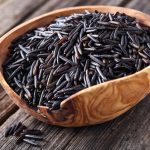
Rice wines are commonly used in Chinese cuisine lending an acidic, flavoursome and aromatic note to savoury dishes. Black rice wine is one of many types obtained from fermentation and subsequent blending of steeped black rice. It is full of modified anthocyanins which have properties often associated with antioxidants. Whilst we might drink it, it also has traditional medicinal value in Chinese lore having been ascribed properties associated with the prevention of cardiovascular disease and cancer (Que et al., 2006). This particular rice wine has a high antioxidant level according to anecdotal sources and remains to be assessed in Western medical research. High performance liquid chromatography (HPLC) is always the method of choice for analysing the polyphenolics in such beverages (Vichapong et al., 2010).
Pigmented rice is especially rich in anthocyanins and polyphenols which have a number of functional nutritional benefits (Hu et al., 2003; Zhang et al., 2010) and are extracted from the pericarp of rice during fermentation. (Shen et al., 2009). The properties of each rice wine generally can be ascribed to individual rice varieties and are obtained from various sources all over South-East Asia (Sompong et al., 2011). Japanese rice wine of an especially dark hue comes from a purple-black variety of rice (Pereira-Caro et al., 2013).
References
Hu, C., Zawistowski, J., Ling, W. & Kitts, D.D. (2003). Black rice (Oryza sativa L. indica) pigmented fraction suppresses both reactive oxygen species and nitric oxide in chemical and biological model systems. J. Agric. Food Chem., 51, pp. 5271–5277.
Que, F., Mao, L., Pan, X. (2006) Antioxidant activities of five Chinese rice wines and the involvement of phenolic compounds. Food Res. Int. 39 pp. 581–7.
Pereira-Caro, G.,Watanabe, S., Crozier, A., Fujimura, T., Yokota, T., Ashihara, H. (2013) Phytochemical profile of a Japanese black-purple rice. Food Chem 141(3) pp. 2821–7.
Shen, Y., Jin, L., Xiao, P., Lu, Y., Bao, J.(2009) Total phenolics, flavonoids, antioxidant capacity in rice grain and their relations to grain color, size and weight. J. Cereal Sci. 49 pp. 106–11.
Sompong, R., Siebenhandl-Ehn, S., Linsberger-Martin, G., Berghofer, E. (2011) Physicochemical and antioxidative properties of red and black rice varieties from Thailand, China and Sri Lanka. Food Chem 124 pp. 132–40.
Vichapong, J., Sookserm, M., Srijesdaruk, V., Swatsitang, P., Srijaranai, S. (2010) High performance liquid chromatographic analysis of phenolic compounds and their antioxidant activities in rice varieties. LWT- Food Sci. Technol. 43 pp. 1325–30.
Zhang, M.W., Zhang, R.F., Zhang, F.X. & Liu, R.H. (2010). Phenolic profiles and antioxidant activity of black rice bran of different commercially available varieties. J. Agric. Food Chem., 14, pp. 7580–7587.


Leave a Reply